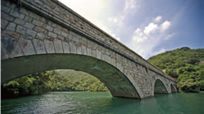Hello, everybody! Thank you for looking our blog!!!^^
Yesterday, we suggested the Old District Office North which is located in Tai Po.
Today, I would like to introduce one of the famous museum in Hong Kong ------ Hong Kong Museum of Coastal Defence.

This museum is formerly known as the Lei Yue Mun Fort, which was the most formidable fortifications in the territory built more than 100 years ago. It was also an important battlefield during the Battle for Hong Kong in 1941. Nowadays, it has been revitalized to preserve and present our 600-year history of coastal defence.
This museum is located in Shau Kei Wan, and the total area is 34,200 square meters. As early as 1844, barracks were built by the British at Saiwan to the south of the channel. However, with numerous deaths of soldiers caused by severe epidemics in the area, the barracks were abandoned shortly afterwards. Although there had been many suggestions to build batteries at Lei Yue Mun in the next forty years, none was ever realized. The construction was largely completed by 1887.

A map of 1895 showing the location of Lei Yue Mun Fort
However, the next three decades saw no hostile actions from Britain's enemies, and the Lei Yue Mun installations were never put to any real test. By the 1930s, the strategic importance of Lei Yue Mun declined considerably as a result of technological advances and the construction of new defence positions in the territory.
On 8 December 1941, the Japanese launched their attacks on Hong Kong. After the fall of the New Territories and Kowloon, the British Forces immediately strengthened the defences at Lei Yue Mun to prevent the Japanese from crossing the Lei Yue Mun Channel from Devil's Peak. Although the defence forces managed to repulse several raids by the Japanese, they were eventually overwhelmed and the Fort finally fell into enemy hands on 19 December. The Fort no longer bore any defence significance in the post-war period, and became a training ground for the British Forces until 1987 when it was finally vacated.
In view of its historical significance and unique architectural features, the former Urban Council decided in 1993 to conserve and develop the Lei Yue Mun Fort into a museum of coastal defence. With a budget of HK$300 million, the Architectural Services Department (ASD) completed the architectural design and construction works. With such splendid architectural design, the ASD was awarded the
Hong Kong Institute of Architects Annual Awards – Silver Medal as well as Green Project Awards – Silver Award (Greening Effect) in 2000. The Museum was open to the public on 25 July 2000 which brought a new page to the history of the Lei Yue Mun Fort.
Let me give you some relevant general information whether you are interested in visiting this museum.
Opening Hours:
Monday to Wednesday & Friday to Sunday: 10 a.m. to 5 p.m.
(The opening hours are extended to 6pm during weekends and public holidays between 1 July and 31 August.)
Closing Days:
Thursdays (except public holidays)
The first two days of the Chinese New Year
Admission Fees:
$10 (standard ticket: for adults and visitors who are not eligible to concessionary fare)
$5 (concessionary ticket: for full-time students, people with disabilities and aged 60 or above)
$7 (group ticket for 20 persons or above)
Free admission for
Museum Pass and
Museum Weekly Pass Holders
Free admission for babies and toddlers below the age of 4
Free admission on Wednesdays
Public Transport:
15-minute walk following road signs from Exit B2 of Shau Kei Wan MTR Station.
No.85 Citybus, running between North Point Ferry Piers and Siu Sai Wan.
No.82X Firstbus, running between North Point Healthy Village and Siu Sai Wan, via Cityplaza.
Location Map:
Please drive towards Sau Kei Wan via the Island Eastern Corridor. Turn left to Tung Hei Road when you drive down the Island Eastern Corridor. You will see the Tam Kung Temple, shipyards and Shau Kei Wan Wholesale Fish Market. Our Museum is located next to the beginning of highway.
Museum Carpark:
The Museum carpark is open to the public between 10:00a.m. to 5:00p.m. (except Thursdays and first two days of the Lunar New Year). Visitors may park their car free of charge for three hours. Disabled visitors may request for exemption at 2569 1500.
Special Arrangements Under Inclement Weather Conditions:
1. | Typhoon Signal No.8 or above: The Museum will be closed. It will be opened as usual within 2 hours after the signal is lowered. The Museum will remain closed if the signal is lowered less than 2 hours before the normal closing hour.
|
2. | Black Rainstorm Warning: If the warning is issued before the opening hour, the Museum will be closed. It will be opened as usual within 2 hours after the warning is cancelled. If the warning is issued during the normal opening hours, the Museum will remain opened.
|
3. | If Thunderstorm Warning, Red Rainstorm Warning or Typhoon Signal No.3 is issued during the Museum opening hours, the museum will remain open. But the Historical Trail will be closed temporarily. All education activities and guided tours held at the Historical Trail will be cancelled and those indoor activities will continue as normal. The Historical Trail will be opened after the warning/signal is lowered, unless there is safety concern. |
Source:
BY ANTHEA


































